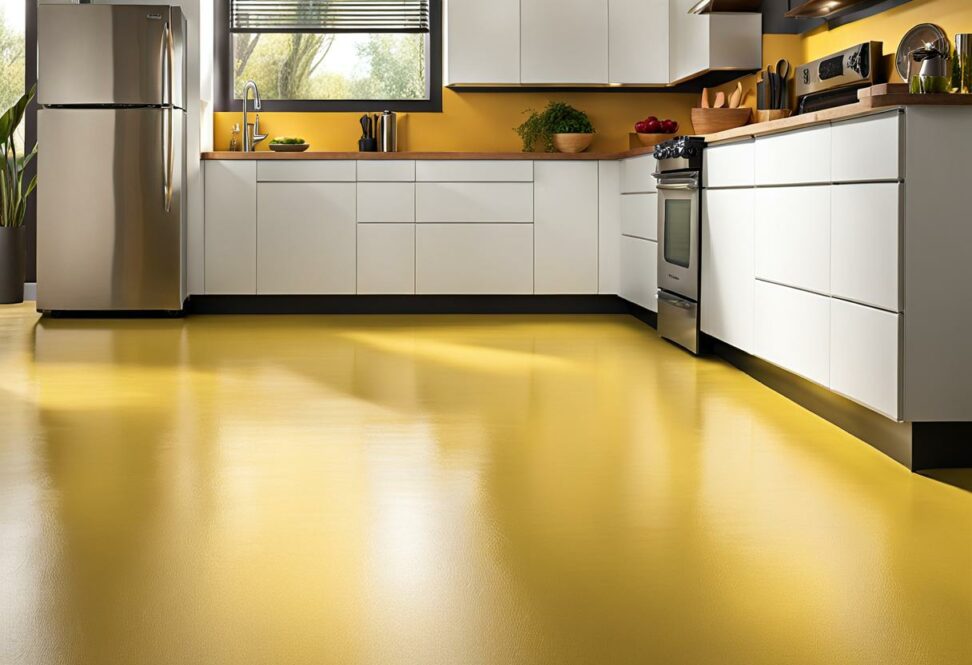Transform Drab Floors with Rustoleum's Kitchen Floor Paint
Does your kitchen have dreary, worn-out floors that make the space feel dull and dated? Transforming your kitchen floors can be an expensive endeavor, often requiring new tile or vinyl flooring installation that costs thousands. However, there is a budget-friendly option to give your floors a fresh new look - Rustoleum floor paint!
Rustoleum offers highly durable and long-lasting epoxy and polycuramine floor paints that can revive and protect your existing kitchen floors. Keep reading to learn why Rustoleum floor paint is ideal for kitchen makeovers, how to prep and apply it correctly, and just how affordable achieving stunning floors can be.
Why Use Rustoleum Floor Paint in Your Kitchen
Kitchen floors take a beating and require flooring that can withstand constant foot traffic, accidental spills, scratches from appliance dragging, and more. Rustoleum floor paint is formulated for durability and provides these advantages:
- Withstands heavy use in high-traffic areas
- Resists stains, household chemicals, and hot tire pickup
- Low odor and fast drying - usable within hours
- Much more affordable than replacing floors entirely
By applying Rustoleum floor paint to your existing kitchen floors, you can renew their appearance while maintaining their structural integrity. It's a budget-friendly way to improve both aesthetics and durability.

Types of Rustoleum Floor Paint for Kitchens
Rustoleum offers both epoxy and polycuramine floor paints suitable for kitchen use. Here are the key characteristics of each:
Rustoleum EpoxyShield
EpoxyShield is Rustoleum's premium epoxy acrylic formula designed for concrete and garage floors. Key features:
- Excellent adhesion to properly prepared concrete
- Highly durable and chemical resistant
- Resists hot tire pickup from appliance or furniture legs
- Enhances worn, old concrete floors
Rustoleum RockSolid
RockSolid is Rustoleum's polycuramine concrete floor coating known for its smooth, uniform finish. Benefits include:
- Withstands heavy foot traffic, dragging furniture, pet claws
- Flexible finish resists cracking or peeling
- Low VOC formula has minimal odor
- Dries quickly within hours for faster project completion
Prep Steps for Painting Kitchen Floors
Proper preparation is crucial for Rustoleum floor paint to adhere correctly and achieve desired results. It's labor intensive but worth the effort.
Clean Surface Thoroughly
Ensure the floor is free of any dirt, grease, wax or other residues. Pressure wash the floor with a degreaser solution if needed.
Etch Concrete Floors
If painting a concrete floor, use a phosphoric acid etching solution to open pores and improve paint adhesion. Rinse thoroughly after etching.
Apply Primer Coat
Applying the recommended Rustoleum primer promotes excellent paint bonding. Use water-based primer for RockSolid floors and oil-based for EpoxyShield.
Application Tips and Techniques
Follow these best practices for a smooth, professional-looking painted floor:
Cut In Edges with Painter's Tape
Crisp edges along walls and trim are easily achieved by taping off borders before rolling on paint. Remove tape immediately after finishing.
Roll On Paint with Medium Nap Roller
Using a roller smoothes out paint and prevents unsightly brush strokes. Choose a medium nap over 1/4" for best results.
Apply Multiple Thin Coats
2-3 thin coats are recommended, allowing proper drying time between each. Thin coats prevent bubbling and create a flawless look.
Cure Time and Cleanup
Allow painted floors 2-4 hours of drying time between coats and 5-7 full days to cure before heavy use. Clean tools promptly with soap and water after painting.
Cost Breakdown of Rustoleum Floor Paint
The typical homeowner can paint their kitchen floor with Rustoleum for around $100-200 in supplies. At $30-60 per gallon and needing 2-3 gallons for the average kitchen, it's exponentially more affordable than a full floor replacement.
Upgrading your kitchen floors no longer means breaking the bank. With proper preparation and application techniques, Rustoleum floor paints provide professional-quality results at a DIY-friendly budget. Their durability, stain resistance, and fast drying times make them ideal for busy kitchen floors. If your kitchen floors need a facelift, Rustoleum provides the affordable solution to transform them from drab to fab.